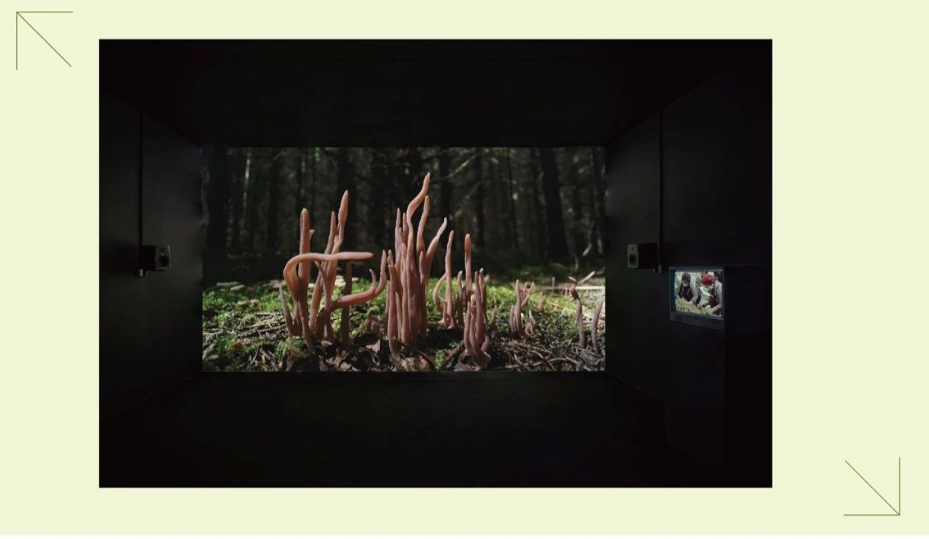Between 2022 and 2023, artist Liu Yujia shot in the Changbai Mountains and the upper reaches of the Songhua River on four occasions.
The film Shimmering Gradual Darkness (2023) sees the frozen Songhua River as a time-traveling portal that
A series of ecological stories are fictionalized by incorporating fragments of ethnography, northeastern literature, and folk myths and legends from the Siberian and Xing’anling regions into the documentary images.
In August 2022, Liu Yujia traveled deep into the Changbai Mountains and was attracted to the “shimmering undergrowth of the forest”, which she considered to be “the soul of forest ecology”.
Under her macro lens, mushrooms, moss, insects, and soil coexist, forming the microscopic jungle in the film Mushrooms (2023).
In Changbai Mountain, she also filmed the Fusong Wanliang Ginseng Market (The Market, 2023), the largest ginseng market in Asia.
This plant, which in Chinese tradition possesses spiritual qualities, in order to fulfill human needs for health and wellness
“ended up becoming a very cheap cash crop” and was caught up in a huge industrial chain, almost losing its spirituality as wild ginseng.
In the 14th Shanghai Biennale in 2023, two of Liu Yujia’s works are presented in the same gallery.
Xiang Zairong, one of the biennale’s curators, said that in Mushroom, which was shown on a large screen, “the huge mushrooms and the sound make us feel immersed, and being there is a kind of spiritual presence in itself,” while Market was shown on one side.
The juxtaposition of the two works constitutes a contrast between the pre-modern and the modern, implicitly pointing to another narrative structure – the presence and disappearance of spirituality.
When Xiang Zairong was involved in the curation of this year’s Biennale, he proposed nine “underground palaces” as the overall structure.
Liu Yujia’s “Remote Reflexology” explores how the dominant forces of the universe act on the body, and uses this as a lens to observe the relationship between humans and non-humans.
Liu Yujia’s work is in this room, along with works by Zhang Wenxin, Su Yongbao, Emma Kunz, and Maria Lai.
Xiang Zai Rong mentioned that when he was setting up the exhibition, he suddenly realized that “there are basically all female artists in that palace, and all of them are gathered in such a field about healing.
There may be something in there that is destined to bring these artists together.”
The world we live in is no longer pure nature, but “second nature” after human intervention.
After the intervention and transformation of suicidal modernity, all things share the same fate.
Even the microscopic creatures that are enveloped in the light of the forest are invisibly affected by climate change.
The boundaries between the primitive and the artificial are not clear-cut.
The ghosts of the pre-modern float in the space and time of modernity, disorienting the order, and discovering new, differently energized relationships.
“Can we say that the artist is the modern shaman?” Xiang Zaerong asks in this podcast.
What new secretions, mixes, and collisions of spiritual thoughts gleaned from the healing of nature can arise in the contemporary era?
Can the artist’s concern for ecology, as he puts it, “give the increasingly stagnant and bureaucratic contemporary art some psychedelic medicine”?
In this issue of “Future Zhiyi”, we invite artist Liu Yujia to discuss with critic and curator Xiang Zairong.
From the frozen snow of Changbai Mountain to the mushroom forests growing on the ground, from the stories of shamans, witch doctors, and isolated Han Chinese couples, we will capture the faint flickering of spirituality.
“The Moment of Zhiyi
Liu Yujia’s Spiritual Journey: From Karamay, Changbai Mountain to Daxinganling, she leaves the city in search of a spiritual dimension beyond modernity.
Mystery vs. the disappearance of mystery: the world of mushrooms under the “dimming light”, the ginseng market in the trade chain.
Korean Witch Doctor, Oroqen Grandmother Singing Zandar: Psychic’s Perception of Spirituality and its Taboos
Is the artist a modern-day shaman? Pure nature no longer exists, and “second nature” is complicated.
Out of Romantic Imagination, Back to the Real World: Non-Human Beings Are Being Affected by Human Activities
The artist’s concern for ecological issues can be a psychedelic antidote to the contemporary art ecosystem.
The Paradox of Bringing “Nature” into Art Museums; Liu Yujia’s Works in Shanghai Biennale’s Exhibition Halls: An Alternative “Psychic” Path
What new entanglements, mixes, secretions and collisions can the pre-modern spirituality produce in contemporary times?
There is no contradiction between preserving national culture and living a modern life, and staying away from modernity can stimulate more of one’s nature.
Shanghai Biennale’s “Seven Palaces of the Earth”: A destiny that brings female artists together in a healing space
The Occult Turn in Contemporary Art: Artists as Psychics, Swinging on Both Sides of the Borderline between the Modern and the Pre-modern
The shape of the future is to be found in the past, exploring a more healing, mystical, and spiritually relevant world.
Artist Liu Yujia’s related works and fieldwork photos






